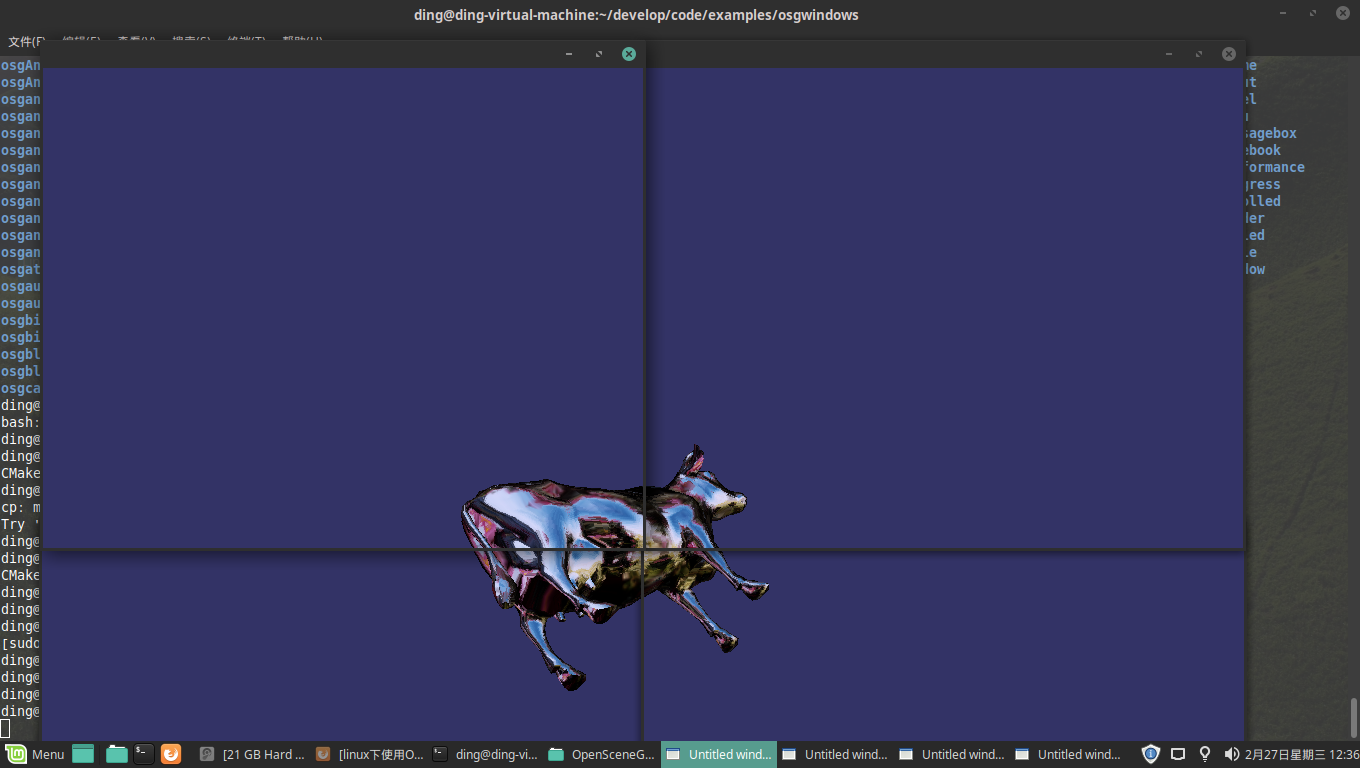Learning OSG programing---osgwindows
/* OpenSceneGraph example, osgwindows. * * Permission is hereby granted, free of charge, to any person obtaining a copy * of this software and associated documentation files (the "Software"), to deal * in the Software without restriction, including without limitation the rights * to use, copy, modify, merge, publish, distribute, sublicense, and/or sell * copies of the Software, and to permit persons to whom the Software is * furnished to do so, subject to the following conditions: * * THE SOFTWARE IS PROVIDED "AS IS", WITHOUT WARRANTY OF ANY KIND, EXPRESS OR * IMPLIED, INCLUDING BUT NOT LIMITED TO THE WARRANTIES OF MERCHANTABILITY, * FITNESS FOR A PARTICULAR PURPOSE AND NONINFRINGEMENT. IN NO EVENT SHALL THE * AUTHORS OR COPYRIGHT HOLDERS BE LIABLE FOR ANY CLAIM, DAMAGES OR OTHER * LIABILITY, WHETHER IN AN ACTION OF CONTRACT, TORT OR OTHERWISE, ARISING FROM, * OUT OF OR IN CONNECTION WITH THE SOFTWARE OR THE USE OR OTHER DEALINGS IN * THE SOFTWARE. */ #include <osgDB/ReadFile> #include <osgUtil/Optimizer> #include <osgViewer/Viewer> #include <iostream> int main( int argc, char **argv ) { // use an ArgumentParser object to manage the program arguments. osg::ArgumentParser arguments(&argc,argv); // read the scene from the list of file specified commandline args. osg::ref_ptr<osg::Node> loadedModel = osgDB::readRefNodeFiles(arguments); // if not loaded assume no arguments passed in, try use default mode instead. if (!loadedModel) loadedModel = osgDB::readRefNodeFile("/home/ding/Downloads/OpenSceneGraph-Data/cow.osgt");
//this path was modified because the OSG_FILE_PATH is not configed correctly in my computer!
//so it is an alternative method
// if no model has been successfully loaded report failure. if (!loadedModel) { std::cout << arguments.getApplicationName() <<": No data loaded" << std::endl; return 1; } // construct the viewer. osgViewer::Viewer viewer; int xoffset = 40; int yoffset = 40; // left window + left slave camera { osg::ref_ptr<osg::GraphicsContext::Traits> traits = new osg::GraphicsContext::Traits; traits->x = xoffset + 0; traits->y = yoffset + 0; traits->width = 600; traits->height = 480; traits->windowDecoration = true; traits->doubleBuffer = true; traits->sharedContext = 0; traits->readDISPLAY(); traits->setUndefinedScreenDetailsToDefaultScreen(); osg::ref_ptr<osg::GraphicsContext> gc = osg::GraphicsContext::createGraphicsContext(traits.get()); osg::ref_ptr<osg::Camera> camera = new osg::Camera; camera->setGraphicsContext(gc.get()); camera->setViewport(new osg::Viewport(0,0, traits->width, traits->height)); GLenum buffer = traits->doubleBuffer ? GL_BACK : GL_FRONT; camera->setDrawBuffer(buffer); camera->setReadBuffer(buffer); // add this slave camera to the viewer, with a shift left of the projection matrix viewer.addSlave(camera.get(), osg::Matrixd::translate(1.0,-1.0,0.0), osg::Matrixd()); } // right window + right slave camera { osg::ref_ptr<osg::GraphicsContext::Traits> traits = new osg::GraphicsContext::Traits; traits->x = xoffset + 600; traits->y = yoffset + 0; traits->width = 600; traits->height = 480; traits->windowDecoration = true; traits->doubleBuffer = true; traits->sharedContext = 0; traits->readDISPLAY(); traits->setUndefinedScreenDetailsToDefaultScreen(); osg::ref_ptr<osg::GraphicsContext> gc = osg::GraphicsContext::createGraphicsContext(traits.get()); osg::ref_ptr<osg::Camera> camera = new osg::Camera; camera->setGraphicsContext(gc.get()); camera->setViewport(new osg::Viewport(0,0, traits->width, traits->height)); GLenum buffer = traits->doubleBuffer ? GL_BACK : GL_FRONT; camera->setDrawBuffer(buffer); camera->setReadBuffer(buffer); // add this slave camera to the viewer, with a shift right of the projection matrix viewer.addSlave(camera.get(), osg::Matrixd::translate(-1.0,-1.0,0.0), osg::Matrixd()); } // left_down window + right slave camera { osg::ref_ptr<osg::GraphicsContext::Traits> traits = new osg::GraphicsContext::Traits; traits->x = xoffset + 0; traits->y = yoffset + 480; traits->width = 600; traits->height = 480; traits->windowDecoration = true; traits->doubleBuffer = true; traits->sharedContext = 0; traits->readDISPLAY(); traits->setUndefinedScreenDetailsToDefaultScreen(); osg::ref_ptr<osg::GraphicsContext> gc = osg::GraphicsContext::createGraphicsContext(traits.get()); osg::ref_ptr<osg::Camera> camera = new osg::Camera; camera->setGraphicsContext(gc.get()); camera->setViewport(new osg::Viewport(0,0, traits->width, traits->height)); GLenum buffer = traits->doubleBuffer ? GL_BACK : GL_FRONT; camera->setDrawBuffer(buffer); camera->setReadBuffer(buffer); // add this slave camera to the viewer, with a shift right of the projection matrix viewer.addSlave(camera.get(), osg::Matrixd::translate(1.0,1.0,0.0), osg::Matrixd()); } // right_down window + right slave camera { osg::ref_ptr<osg::GraphicsContext::Traits> traits = new osg::GraphicsContext::Traits; traits->x = xoffset + 600; traits->y = yoffset + 480; traits->width = 600; traits->height = 480; traits->windowDecoration = true; traits->doubleBuffer = true; traits->sharedContext = 0; traits->readDISPLAY(); traits->setUndefinedScreenDetailsToDefaultScreen(); osg::ref_ptr<osg::GraphicsContext> gc = osg::GraphicsContext::createGraphicsContext(traits.get()); osg::ref_ptr<osg::Camera> camera = new osg::Camera; camera->setGraphicsContext(gc.get()); camera->setViewport(new osg::Viewport(0,0, traits->width, traits->height)); GLenum buffer = traits->doubleBuffer ? GL_BACK : GL_FRONT; camera->setDrawBuffer(buffer); camera->setReadBuffer(buffer); // add this slave camera to the viewer, with a shift right of the projection matrix viewer.addSlave(camera.get(), osg::Matrixd::translate(-1.0,1.0,0.0), osg::Matrixd()); } // optimize the scene graph, remove redundant nodes and state etc. osgUtil::Optimizer optimizer; optimizer.optimize(loadedModel); // set the scene to render viewer.setSceneData(loadedModel); return viewer.run(); }
The routine of each slave camera is alike. While the key point is this sentence:
viewer.addSlave(camera.get(), osg::Matrixd::translate(-1.0,1.0,0.0), osg::Matrixd());
This sentence set the viewpoint of slave camera,which translate the position of view point. Four slave camera view the common model in different direction, combine together.
the command to complie this program is following:
g++ -o osgwindows_1 osgwindows_1.cpp -losg -losgDB -losgViewer -lOpenThreads -losgUtil
After compling, just run it with:
sudo ./osgwindows_1
The outcome of above program is shown:

Like moniter constructed with four screen. Drag mouse in one window, the model will rotate in other three screen meanwhile. Great!


